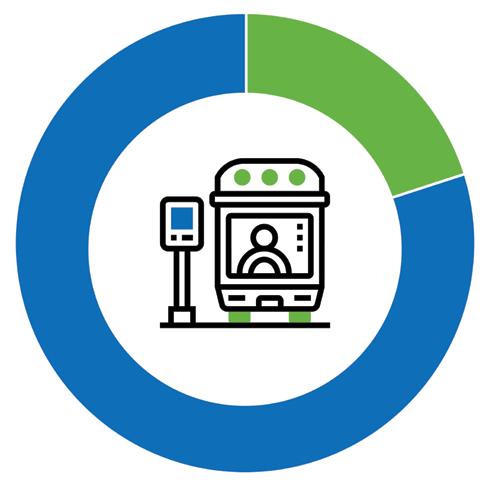
7 minute read
3.9 Results from Outreach Events
The following is a summary of the stakeholder interviews which consisted of 17 questions. The responses listed are a brief recap of their responses and trends.
1) How often they rode the bus:
Advertisement
Eight of the ten riders use Omnitrans almost daily, while only one does not ride regularly. Only one of the ten participants has changed their riding frequency from every day to once a month due to concerns about COVID-19. Riding times typically included mornings and evenings.
2) What are your top three concerns when waiting at bus stops?
» Lighting (Concern for 8 riders) » Unhoused individuals sleeping/residing at bus stops » Trash » Proximity between stops » Frequency/Schedule » Shelter/Seating
3) At bus stops, have you felt uncomfortable or unsafe as far as your personal safety? What made you feel unsafe?
» Seven out of ten riders stated they felt unsafe as far as their personal safety. The leading source was the presence of people experiencing homelessness or lack of lighting. » One rider did not feel unsafe. » One participant shared concerns about experiences with bus drivers on two different occasions.
80%
4) At which streets / cross-streets did you feel uncomfortable or unsafe for your personal safety? During what times of day?
Locations and times where concerns were expressed included:
» Marygold Ave and Sierra Ave (morning and evening; all day; bus stops at 6pm on Sundays). This location was mentioned three times. » E St and Highland » E St and Marshall (during the daytime) » E St and Baseline St (the sbX line, around lunch time or 1pm) » Randall Ave and Sierra Ave » Foothill Blvd and Citrus Ave (all day) » Del Rosa Ave by San Bernardino Ave (close to the Casino and by
Terrace Mall, evening hours) » Carousel Mall and 2nd St (evening hours) » Shandin Hills and Kendall » Route 312 / Treten St and Medical Center (day and evening). There is no light at the bus stop or on your way to the stop. Even during the day, the bus stop is not visible by drivers. It is closer to the grass,
Treten St.
5) Did you overcome being uncomfortable, if so, how did you do it?
Most responses emphasized not being able to overcome feeling uncomfortable and needing to be on high alert, using the flashlight on their phone, and/or carrying pepper spray. Whenever it was possible, riders moved to a different stop.
Community Outreach 03
6) Have you felt unsafe as far as traffic safety while walking or biking to the bus stop?
The responses were split in half. Half of the riders felt unsafe as far as traffic safety, while the other half did not feel unsafe.
7) At which streets / cross-streets did you feel unsafe or uncomfortable at a bus stop? During what times of day?
The locations where participants felt unsafe were identified as:
» Highland/State St: There are food trucks and food carts. The 312 bus has to pull up in the middle of the street. » Linden/Merrow: All the time. There is no curb. Riders are waiting on the dirt. » Foothill/Mango: A lot of heavy traffic. Stop is close to the street. » Sierra (between Spring St and Arrow): There’s no seating, or shelter.
Only signage. But it is close to the street. It is hard for the drivers to see the riders waiting for the bus. You often see riders running after the bus after they’ve been passed. The area has people experiencing homelessness hanging around, so it’s hard for drivers to differentiate if the riders are waiting for the bus. This location also has poor lighting, so it’s even worse at night. » Foothill and Hamlock: Late morning (10am/11am ). » Baseline/E St (and all stops): Cars making turns at all times of day » G St/Mills St: During the day.
8) Have you had trouble accessing the bus stop while walking or using a mobility device?
Results were split in half with 50 percent of the participants not having trouble accessing their bus stop while the other 50 percent did. None of the ten participants used a mobility device.

9) At which streets / cross-streets do you feel unsafe accessing a bus stop? During what times of day?
» 16th St/State St both in the morning and afternoon. Food carts will park there all day. » Linden/Miro (between Alder and Linden) - all day » College & University in front of the Ralphs shopping center. There is poor lighting. » Foothill and Hamlock » Arrowhead and Highland - all day » Del Rosa area in San Bernardino. Bus route 1.
10) Which problems at those locations made it difficult for you to access the bus stop? For example: fast moving traffic, poor lighting, poorly marked crosswalks, etc.
» “It is lacking shade. I have suffered heat exhaustion. I had to walk 35-40 minutes, and still had to wait to be let on the bus for another 20 minutes. This was in over 100-degree weather. I collapsed once
I was let inside the bus.” » “16th St/ State St. It has poor lighting at the street and no light on the stop.” » “Lincoln/State St has no lighting on the street and no lighting at the stop.” » “Bus drivers don’t see riders at the stops and it’s worse at night.” » “There is no sidewalk.” » “The stop on Sierra between Spring and Arrow, close to Metrolink,
drivers easily pass riders waiting there. Maybe the drivers drive quickly to get to the Metrolink station.” » “There is one or two cars obstructing access either at the pawn shop or liquor store. It’s a BIG problem.” » “Fast moving traffic, poor lighting on the way to the bus stop and at the bus stop. I’ve been missed by the driver because he didn’t see me waiting at the stop. It’s that dark.” » “Lack of lighting.” » “No sidewalks.”
11) Are there any issues with the sidewalks surrounding the bus stops you use? For example: uneven sidewalk, tree roots, too narrow, missing sidewalk, objects blocking the sidewalk, etc.
Three riders responded no to this question. The others identified the following issues:
» “There is no shade on my way to the bus nor at the bus stop.” » “On Miro (between Alder and Linden) there is no sidewalk.” » “In Fontana, behind Kaiser Hospital, there is a four-way stop. On Palmetto and Marygold. The stop is on dirt. It’s a tough spot to access.” » “There is no sidewalk to walk on 16th and Medical St stop for route 312. Others are fine.” » “Several but mostly Foothill and Hamlock.” » “There are cracks on the sidewalk and people blocking the street.” » “There are uneven sidewalks.”

of those interviewed did have trouble accessing the bus stop
12) Which streets do you find these issues? (at which cross streets / where?)
» Miro (between Alder and Linden) » Palmetto/Marygold » 16th/Medical » Foothill/Hamlock » E St/Baseline » Highland/E St, Line 6 » Gold St » 2nd St/Lorena
13) Are there any additional concerns about bus stops that you would like for us to know?
Three riders had no additional feedback. The other seven restated some of their concerns. The following are listed in no particular order.
» Lighting » Frequency » Distance between stops » Cleanliness » Shade/Shelter » Visibility » People experiencing homelessness » Signage
Community Outreach 03
14) What bus stop improvements would help you feel safer? For example, lighting, surveillance cameras, emergency phone, seating, shelter, etc. (used examples only if they didn’t have a response).
Recommendations included:
» Lighting (solar and regular) at stops » Shelter » Proximity between stops » Paint bus stop curbs red » Button at stop to alert bus drivers to people waiting at stop » Stop maintenance/cleanliness
15) What else would make you feel safer as far as personal safety at and around bus stops?
A summary of the responses includes the following list:
» An emergency phone at the bus stop » Emergency call button INSIDE the bus (like with light rail trains) » Safety personnel at specific locations » PPE enforcement during COVID » Extra masks/disinfectant on buses » Shelter at bus stops » Bus frequency » No smoking/drinking/loitering signs » Bus stop inspections for cleanliness
16) What would make you feel safer as far as traffic safety while walking, using a mobility device, or biking to the bus stop? For example, speed humps, curb extensions, bike lanes, pedestrian-friendly traffic signal measures, etc.
Responses from riders included:
» Improve street conditions » Curb extensions » Pedestrian/crosswalk reflectors » Additional traffic signals » Pedestrian signage for private driveways » Speed humps » Enforcement » Bus frequency » No loitering signage
17) Have you used Omnitrans’ transit app, or Nextrip real-time arrival information system? If not, were you aware of these apps? Do these apps help you feel safe?
Most riders have used one or all the Omnitrans’ apps. The majority felt the apps are helpful but don’t necessarily improve their safety perception. Only three riders felt the apps made them feel safe. All commented on the app’s accuracy, stating the app did not always reflect delays.





